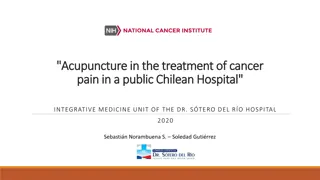Acupuncture Profession Challenges and Competencies Assessment
The content discusses the challenges faced by the acupuncture profession in terms of income and authority compared to mainstream health professions. It emphasizes the importance of developing competencies, knowledge, skills, and abilities (KSAs) to achieve professional status and align with other well-established professions. The comparison of four health professions, the role of social authority, and the need for competencies adoption in the field of acupuncture are highlighted.
Download Presentation

Please find below an Image/Link to download the presentation.
The content on the website is provided AS IS for your information and personal use only. It may not be sold, licensed, or shared on other websites without obtaining consent from the author.If you encounter any issues during the download, it is possible that the publisher has removed the file from their server.
You are allowed to download the files provided on this website for personal or commercial use, subject to the condition that they are used lawfully. All files are the property of their respective owners.
The content on the website is provided AS IS for your information and personal use only. It may not be sold, licensed, or shared on other websites without obtaining consent from the author.
E N D
Presentation Transcript
2nd World TCM and Acupuncture Forum March 31 and April 1 2019
STEVEN H. STUMPF, EDD NATIONAL GUILD OF ACUPUNCTURE AND ORIENTAL MEDICINE NGAOM
COMPETENCIES are KNOWLEDGE, SKIILLS and ABILITIES [KSAs]
The goal of every profession, if it is to survive and prosper, must be to remove perception as a relatively weak, traditional profession of minor economic significance.
IS THIS TRUE ABOUT THE ACUPUNCTURE PROFESSION?
Among comparable midlevel mainstream health professions acupuncture has the lowest income and the least authority.
TABLE 1: COMPARISON OF FOUR HEALTH PROFESSIONS ESSENTIALS national practice definition educational conformity national scope of practice PROFESSION KSAs Medicine 1880s 1896 1920s 1920s Physician Assistant Physical Therapy Nursing 2006 1986 - 1996 1965 1965 1920s 1950s - 1977 1986 1986 1912 1952, 1969 1917 1955 1972 Chiropractic 1981 1960s no no Naturopathy 1910-1930 1980s 1990s no no Acupuncture no 1982-1985 no no
Social authority involves the control of action through the giving of commands. This is commonly expressed as writing orders in charts which others follow.
WITHOUT COMPETENCIES CREATED AND ADOPTED BY PRACTITIONERS, LACs WILL NOT ACHIEVE PROFESSIONAL STATUS ALONGSIDE THOSE PROFESSIONS THAT HAVE DEVELOPED THEIR OWN KSAs.
RNs execute orders with the exception of Nurse Practitioners who may write orders just like MDs and PAs!
Cultural authority entails the construction of reality through definitions of fact and value. For TCM this means teaching energetic theory, and an Americanized version of Chinese medicine.
For mainstream medicine practitioners these concepts are quaint at best; nonsense at worst.
This idea would be more main stream!
Professional competencies emerge from the organization that represents the licensed practitioners. These competencies are uniformly agreed upon and formally adopted in by-laws and other declarations of what it means to be a practitioner.
Such uniformity is found in medicine, osteopathy, naturopathy, nursing, physical therapy, and the physician assistant profession, among others.
Every health profession has its problems
Historically, acupuncture has been organized around strict allegiance to non-Western culture, i.e., Traditional Chinese Medicine, energetic theory, and Orientalism.
According to acupuncture historian Mark Seem (2011), the process of establishing acupuncture was directed by the organization representing training programs.
KSAs are not required as part of ACAOM accreditation
Seem contends that a compromise was sought between factions who differed whether biomedicine or Traditional Chinese Medicine should be the underlying basis of acupuncture training.
This long-standing factionalism East vs West - produced compromised outcomes that have prevented unified support and direction.
Acupuncture remains OUTSIDE the medical mainstream. The consequences harm LAcs in terms of income and medical authority.
The historical success of a profession rests fundamentally on the growth of its particular source of wealth and status its authority. Paul Starr, The Social Transformation of Medicine.
A profession will have established itself with professional authority when professional competencies have emerged from the organization that represents the licensed practitioners.
Competencies drive training, which creates professionals that can be relied upon to behave and perform similarly across states and national borders.
K S A
KSAs KNOWLEDGE, SKILLS AND ABILITIES ARE THE BUILDING BLOCKS OF PROFESSIONAL EDUCATION AND PRACTICE SUCCESS
THE ACUPUNCTURE PROFESSION DOES NOT HAVE UNIFORM KSAs UNLIKE NEARLY EVERY OTHER MAINSTREAM MEDICAL PROFESSION
What Are Competencies? Competencies are the knowledge, skills, and abilities (KSAs) needed to succeed in professional roles. They are the traits or characteristics needed for successful job performance
Competencies define proficient performance of critical work functions in defined work settings. Well-written competencies are quantifiable and focused on performance and outcome.
Competency-based health profession education is the national and international gold standard for professional education.
KSAS Knowledge Skills and Abilities minimum KSAs maximum KSAs set standard criteria for LICENSING set optimal, most desired criteria for board CERTIFICATION purpose minimum necessary to become licensed acupuncturist among best in her profession target highest qualified licensed professionals licensing agency created by licensee has minimum skills required to meet licensing requirements licensee has top quality training and practice value NCCAOM, CAOMA, NGAOM, AAAOM, ASA, CAA state licensing board orgs
Competencies created and adopted by practicing professionals provide the basis for a profession to regulate itself.
A scientific approach: the first step is to name and define the terminus for the occupation. OMD? MTOM? MSAOM, DAOM?? Too many degree names indicates no uniform standards.
The main step is to map out and define the competency domains or higher-level groupings of KSAs.
These competencies are uniformly agreed upon and formally adopted in bylaws and other declarations of what it means to be a practitioner. Such uniformity is found in medicine, osteopathy, naturopathy, nursing, physical therapy, physician assistant
These are NEW competencies for the 21st century.























